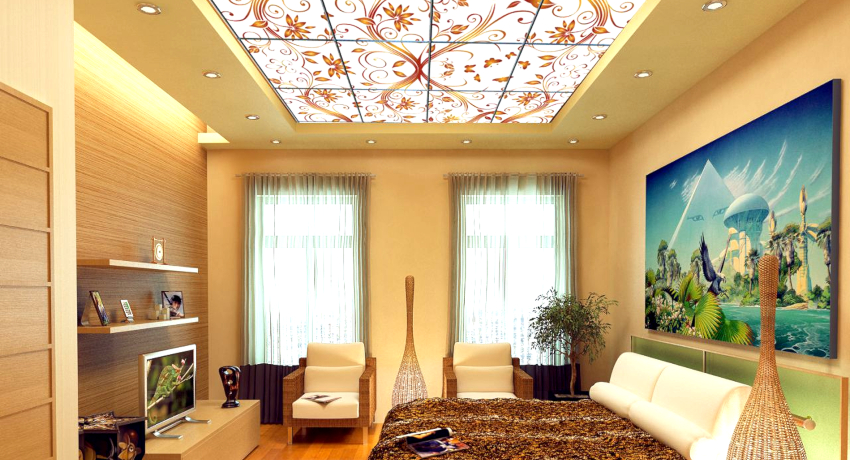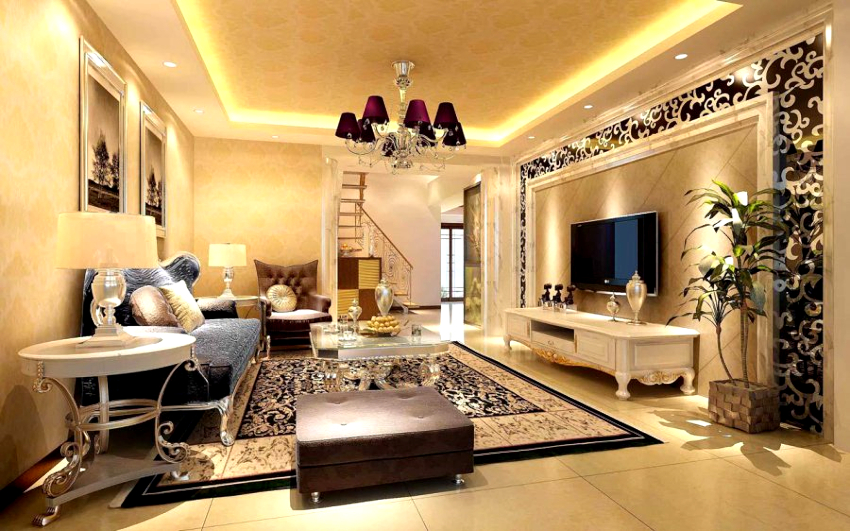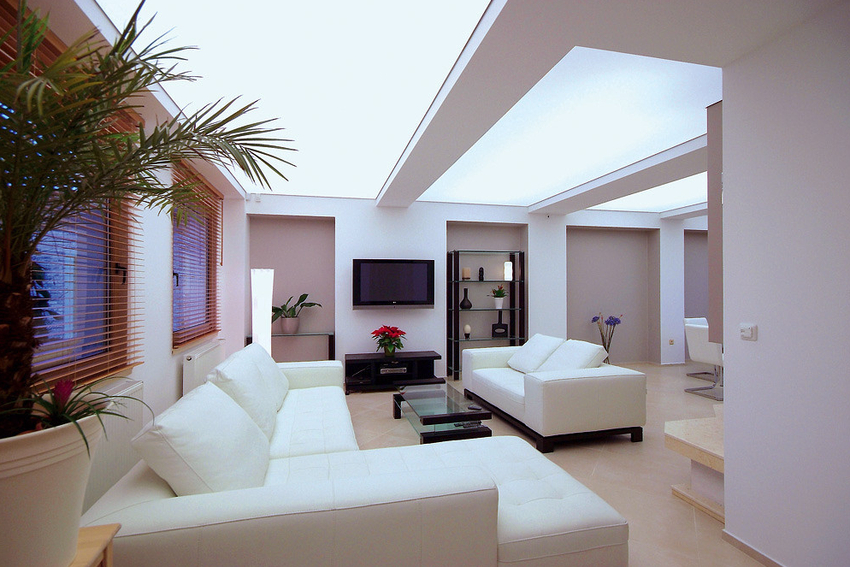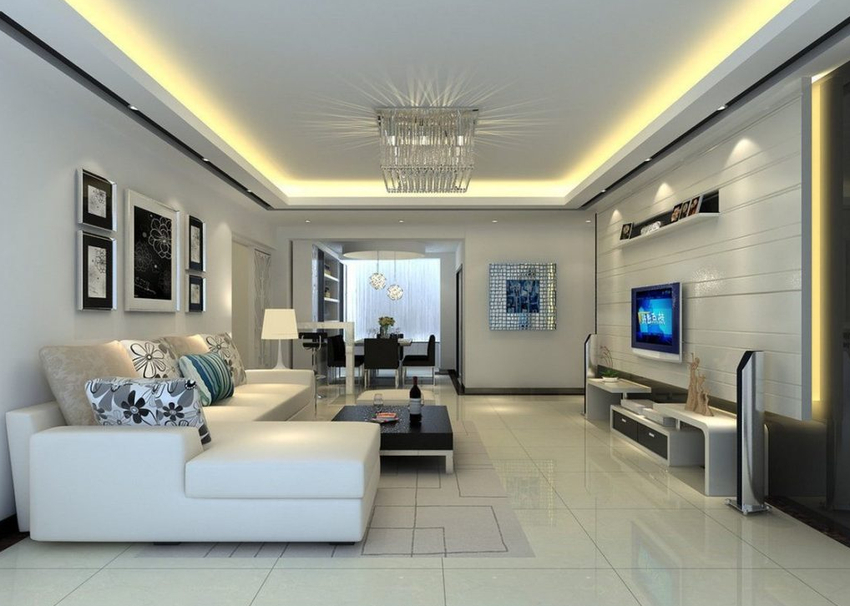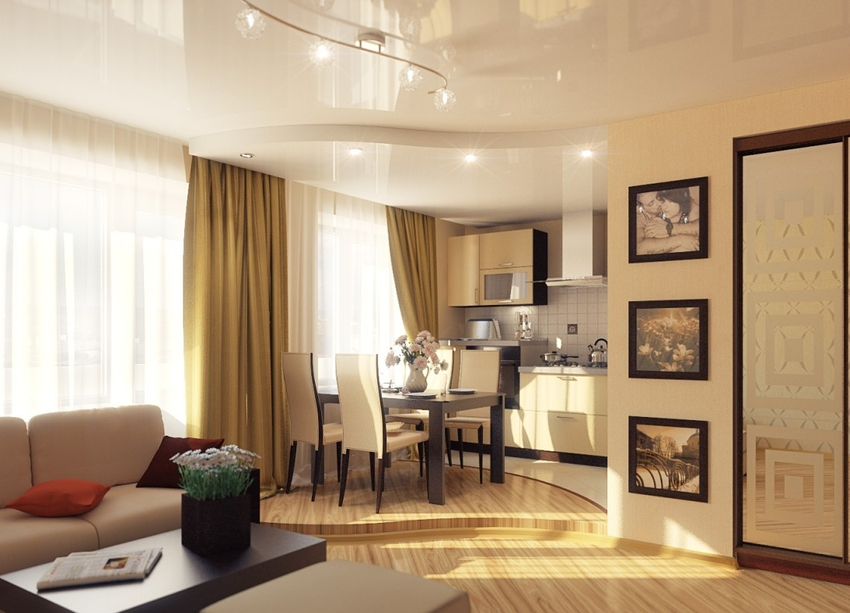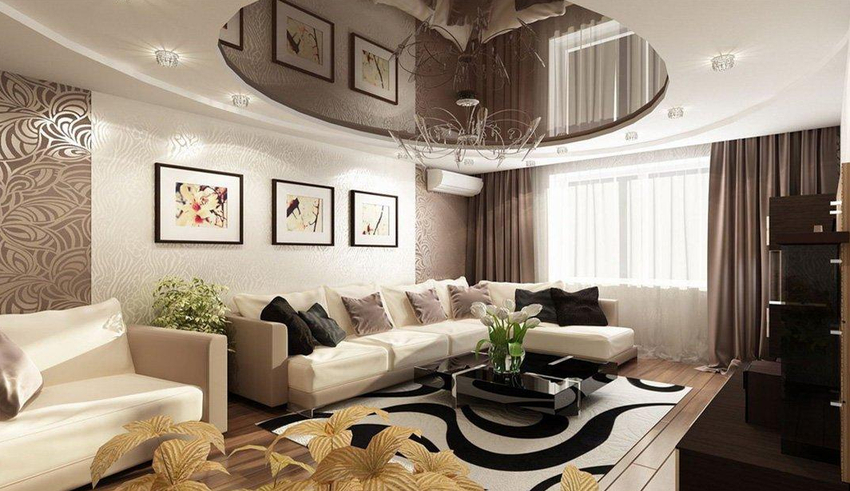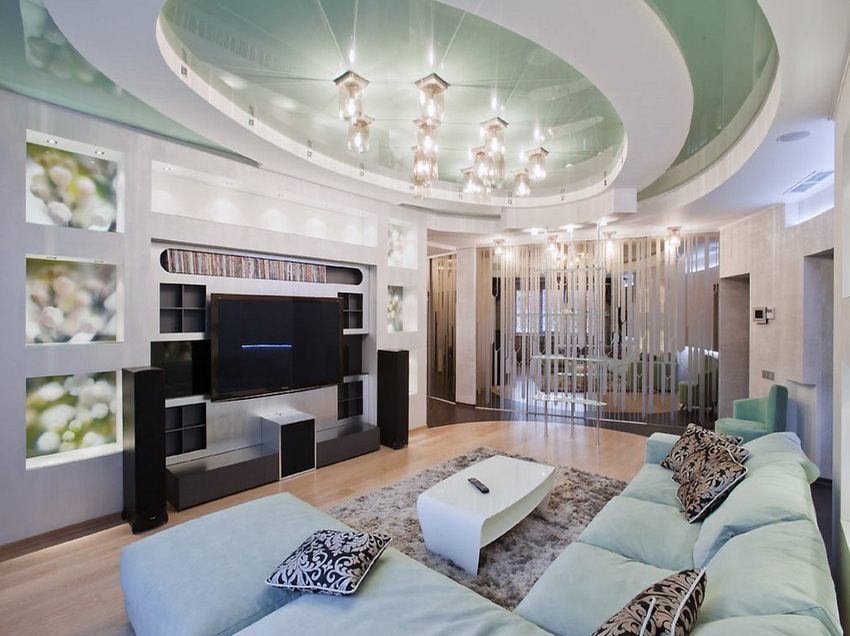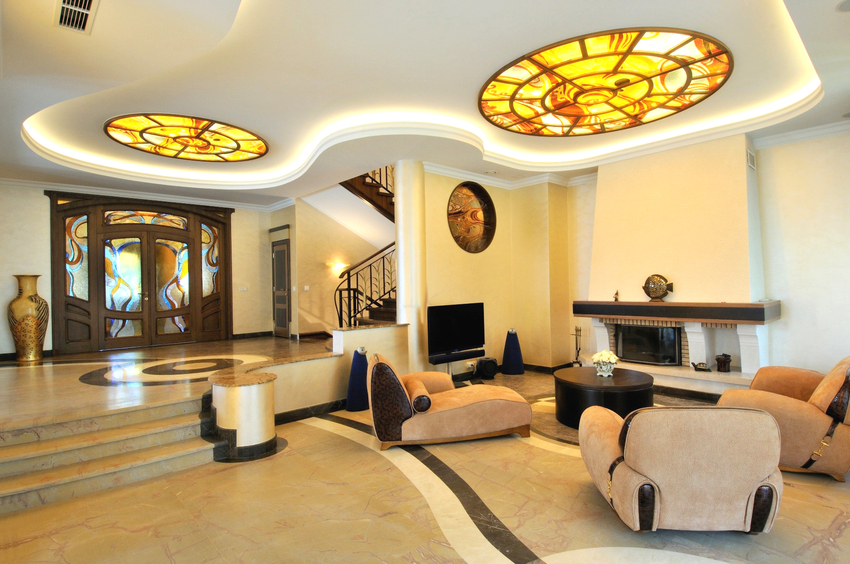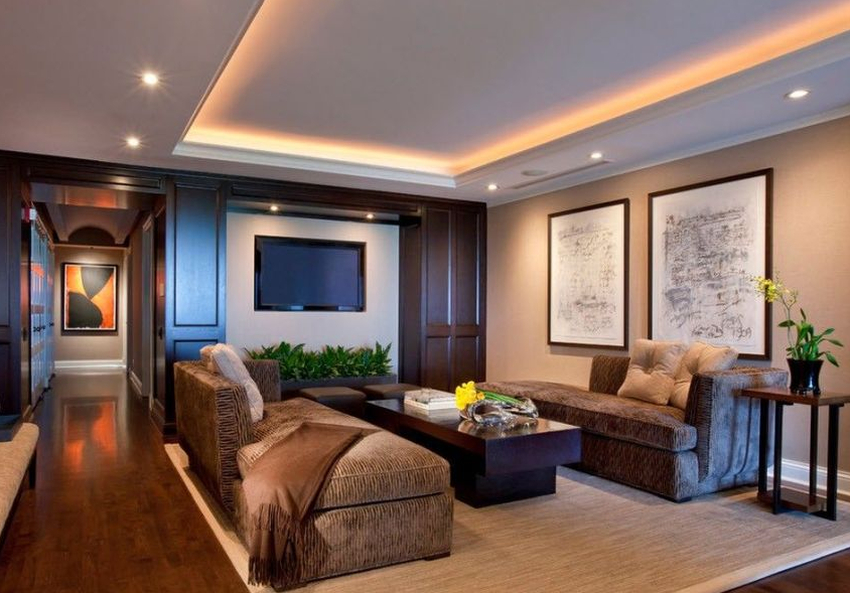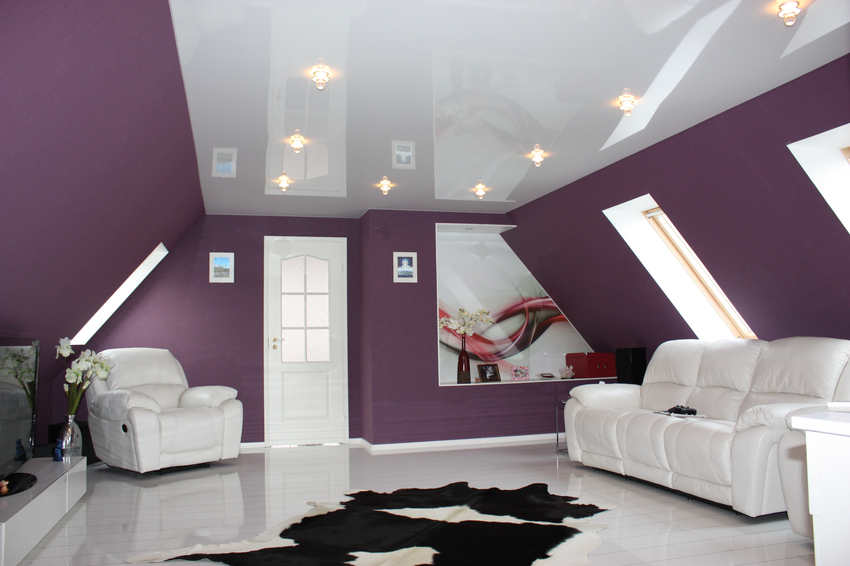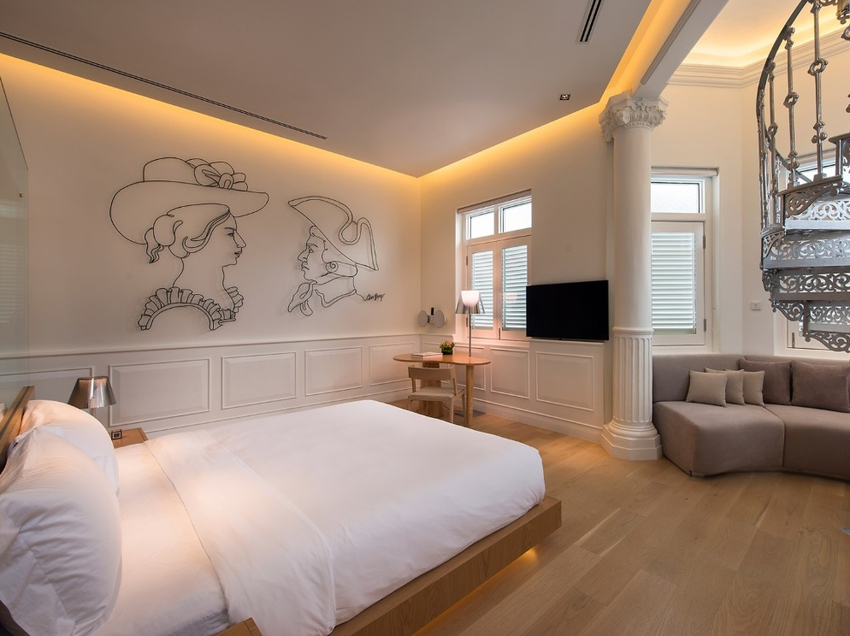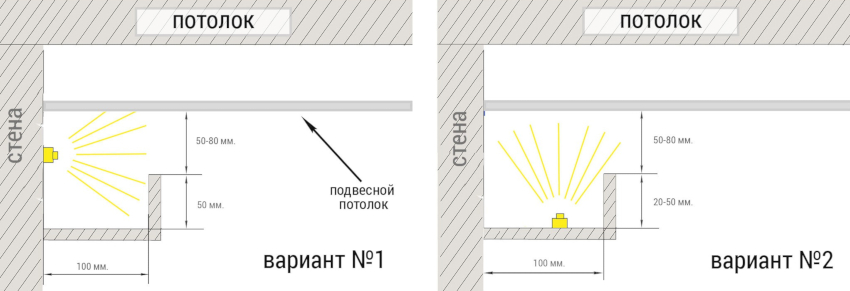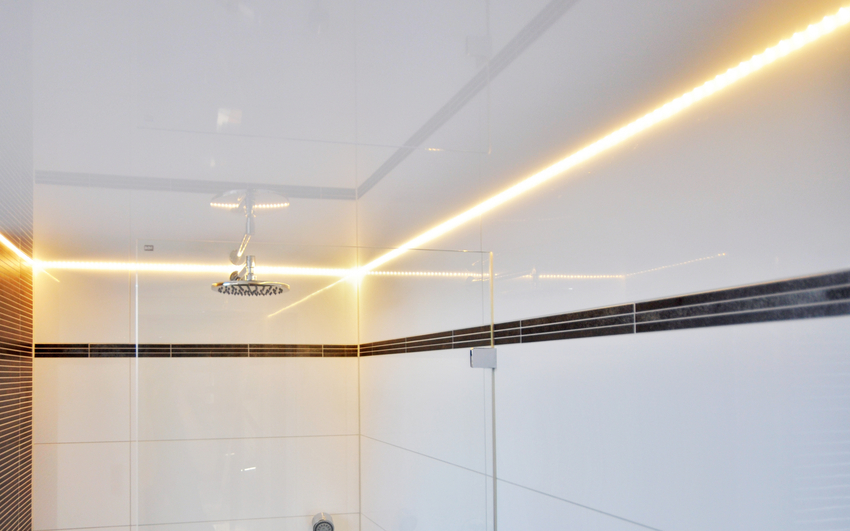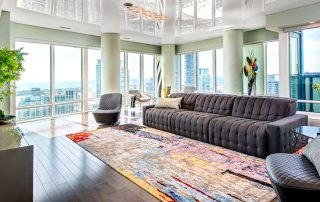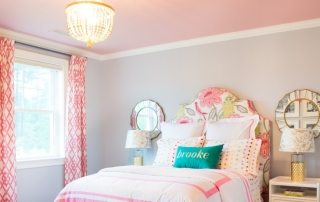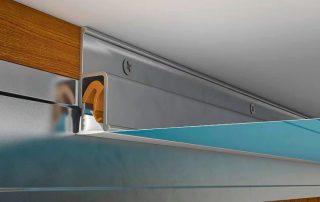The ceiling is one of the main elements of the interior of the room. The perception of the overall design concept of the room depends on the degree of uniqueness and originality of its design. One of the most stylish and aesthetic options is the backlit stretch ceiling. The design can have a different configuration, texture, color shade and design.
Content [Hide]
- 1 Backlit stretch ceiling: design features
- 2 Advantages and disadvantages of backlit tension structures
- 3 PVC stretch fabric texture for ceilings
- 4 The shape of two-level stretch ceilings with lighting
- 5 Color palette of backlit stretch ceilings
- 6 Design solutions for the design of stretch ceiling space
- 7 Varieties of lighting for a stretch ceiling
- 8 Features of a stretch ceiling with lighting around the perimeter
- 9 Arrangement of stretch ceiling with LED lighting
- 10 A kind of backlit stretch ceiling: a floating ceiling
- 11 Organization of illumination of a stretch ceiling with LED strip
Backlit stretch ceiling: design features
Stretch ceiling consists of a frame of a certain configuration, to which the canvas is attached. The box is characterized by its lightness, due to which there is no additional load on the base. To fix the tensioning web, special fasteners are used, which makes the structure reliable and durable. This design does not differ in labor-intensive installation. A simple single-level ceiling can be arranged by yourself.
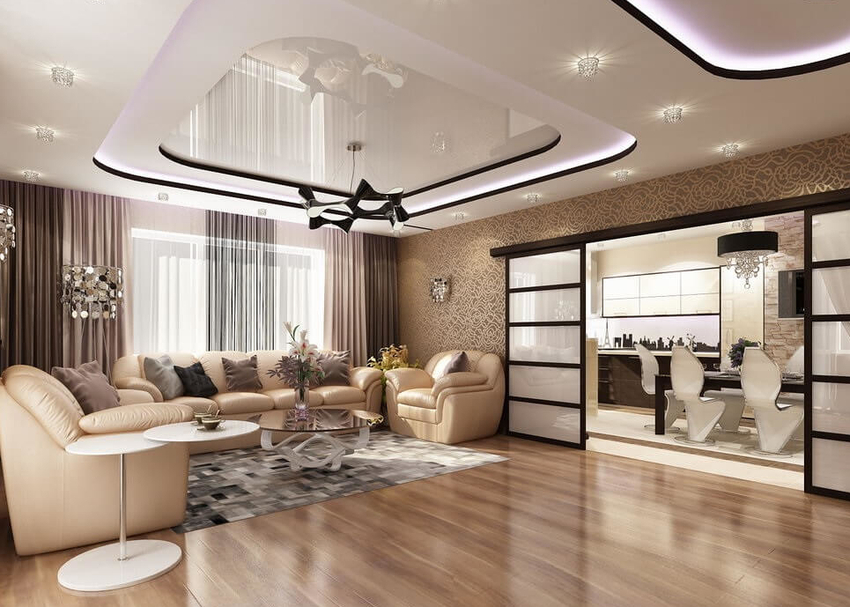
The backlit stretch ceiling looks beautiful and aesthetically pleasing due to the uniform tension of the canvas and rigid fixation to the frame
Important! When installing a stretch ceiling, it is not required to prepare the base, which reduces labor intensity and cost of work.
A fabric or film synthetic material made on the basis of PVC is used as a stretch fabric. The first option is environmentally friendly. As you can see in the photo, the perimeter-lit stretch ceiling looks impressive and expensive due to the pronounced structure of the material.
The second version of the canvas is characterized by high technical and operational qualities. The film is treated with special impregnations, as a result of which the material is moisture resistant and vapor permeable. No condensation forms on the back of the ceiling. The coating is resistant to temperature extremes, exposure to ultraviolet rays, so it does not fade in the sun.
The ceiling surface looks neat and aesthetically pleasing due to the uniform tension of the material and its rigid fixation to the frame. Correct installation is the key to an even surface without folds or sagging.
The stretch ceiling can be single-level, double, three-level and multi-level. Arrangement of the first type of surface in some cases does not imply the use of a drywall box. Elements that perform a decorative function can be used here in the form of molding, baguette, ceiling plinth, imitations of gypsum stucco molding. Luminaires for stretch ceilings with illumination in the form of ribbons are most often mounted to them. In this case, the best solution is to use flexible tape.
Illuminated multilevel stretch ceilings look very presentable and original. They look most advantageous in high rooms. Here you can create a design of a bizarre configuration, which will bring uniqueness to the interior. Also, with the help of a stretch multi-level ceiling, you can zone the room, highlighting accent points.
Advantages and disadvantages of backlit tension structures
Arrangement of the tension structure allows you to hide all irregularities and surface defects, and a properly created backlight is able to skillfully beat the ceiling configuration, exposing some projections, broken lines and bends in a favorable light. With its help, you can create three-dimensional and realistic images on the surface. Interesting solutions are shown in the photo of backlit stretch ceilings.
For a stretch ceiling, you can use various sources of artificial light, which are presented in a wide variety, where the elements differ in design, color shade.
Helpful advice! There is an RGB backlight that can periodically change the color of the light output.
At the same time, you can use several types of lighting in a stretch ceiling, creating central and auxiliary lighting. This technique also allows you to erase the boundaries of the overlap, filling the room with air and lightness. The stretch cover is durable. With proper care and careful operation, such a ceiling is able to maintain its original technical qualities for a long time.
However, a stretch ceiling with spotlights has its drawbacks. Dark spots form on its surface. To eliminate this, you will need to use a large number of lamps, which will be very expensive. In addition, for the installation of light sources, it is necessary to perform a rigorous calculation in order to prevent the formation of excess illumination power, which will negatively affect the organs of vision.
Arrangement of the tension structure reduces the height of the walls by 8-10 cm. However, the imbalance can be corrected by means of properly organized lighting. In rooms with high ceilings, such a disadvantage is hardly noticeable. The material is unable to withstand significant mechanical damage and punctures.
PVC stretch fabric texture for ceilings
Depending on the texture, PVC stretch fabric can be glossy, matte and satin. The first option is very popular in modern interiors. The backlit glossy stretch ceiling is characterized by good reflectivity, which allows you to visually increase the spaciousness of the room. This texture most advantageously emphasizes the synthetic base and the manufacturability of the raw materials.
A type of glossy coating is a mirror type of surface that reflects everything that is located below.Such a ceiling is capable of creating a visual imbalance, therefore it is better to use it as separate accents against the general background, combining it with a suspended version of a drywall construction.
A matte ceiling will naturally look, the special texture of which softens the reflective properties of the coating. Such a surface does not create the effect of emotional stress, due to which the overall atmosphere of the room will be more cozy and comfortable.
In addition, the matte canvas provides a more expressive transfer of the image that is created on the surface, as can be seen in the photo of the backlit stretch ceiling in the hall. This is made possible by the absence of glare from the backlight on the surface. When caring for a matte surface, you can use wet cleaning, which does not contribute to the creation of visible streaks.
Satin fabric is a pearlescent surface that has little reflectivity. Thanks to the light silky texture with a pleasant shimmer, the contoured stretch ceiling gains expressiveness.
Synthetic cloth assumes extremely dry cleaning of the surface. Such material is characterized by a higher cost. He is able to emphasize the status of the owners. However, when decorating the interior, a careful approach to the selection of each of its details will be required to obtain a harmonious composition.
The technical and performance characteristics of the material are superior to those of the other two surface types. The synthetic canvas is frost-resistant, so it can be used to decorate unheated rooms. The material harmonizes well with any illumination option, which does not leave glare on the surface.
The shape of two-level stretch ceilings with lighting
The ceiling space can be made in various shapes using interesting visual effects. This will add originality and uniqueness to the room. The most popular is the square design, the sides of which are formed using drywall, and the interior space is played with a stretch canvas. This design brings expressiveness and dynamism to the interior, enlivening it.
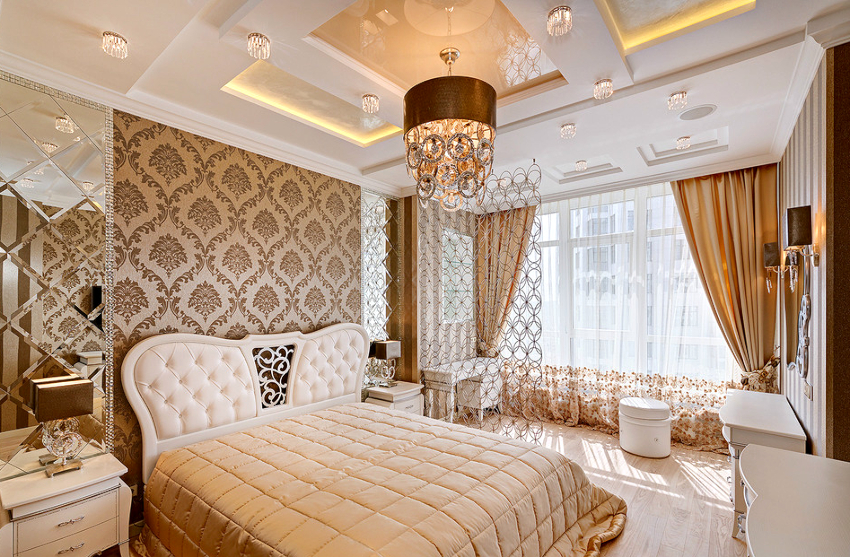
Properly designed lighting is able to beautifully beat the protrusions, broken lines and bends of the ceiling
A rectangular stretch ceiling looks stylish, strict and modern, which is especially important for living rooms. It is enough to create a plasterboard frame around the perimeter of the room, supplementing it with spot lighting, and stretch the canvas, in the central part of which a beautiful chandelier should be located. This concept allows you to combine all the elements of the interior into a single composition, giving it a complete look, which is demonstrated by the photos of two-level stretch ceilings with lighting in the hall.
A two-level round-shaped tension structure in the form of an ellipse, oval or circle will help smooth out the sharp corners of the space. Unusual lighting can add depth to the interior.
A popular solution is the arrangement of an L-shaped ledge or wavy podium on the ceiling. This solution is often used for zoning a room, creating accent areas in the room, which are played up with central or auxiliary lighting, as shown in the photo of two-level stretch ceilings with lighting in the kitchen.
A curvilinear tension structure is capable of giving the interior originality and individuality. A special effect will be created by contour lighting, complemented by spotlights.
Decorative elements can be made on the ceiling using a tension structure.The image of a flower in various designs is very popular, which will noticeably revive the interior.
Color palette of backlit stretch ceilings
The color scheme of the ceiling space is a determining factor in the perception of the external appearance of the room. White is considered traditional. It visually expands the boundaries, making the room more airy and bright. Original solutions are shown in the photo of a white stretch ceiling with lighting. Combined with black, it creates a bold and surprising contrast.
The tandem of white and brown is distinguished by harmony and attractiveness. The combination of white and beige shades will give the interior a touch of nobility. The ceiling space in white and green looks gentle and fresh.
Gray ceiling in a glossy design looks stylish, elegant and fashionable. Such restrained neutrality of the finish emphasizes the good taste of the owners. The black glossy ceiling looks bold and expressive. It adds depth and magic to the room. For the best effect, it must be correctly illuminated. A good solution is to choose a crystal chandelier for a stretch ceiling (the photos clearly demonstrate this).
To create a romantic mood, the best option would be a purple ceiling. Such a gentle, flying surface is capable of giving a room of mystery and mystery.
A ceiling created on a color contrast looks advantageous, for which 2-3 shades are used in combination with matte white. You can equip a colored niche by balancing it with a plain background, as shown in the photo of a backlit stretch ceiling in the hall.
Synthetic fabric for tensile structures can be of any shade. The traditional color is white, which will soften any color scheme of the interior, giving the surface lightness and weightlessness. Beige, cream, peach and milky shades are also popular.
For the bedroom, you can use bleached turquoise, lilac, pink and ivory. The kitchen should be enlivened with fresh dynamic tones in the form of yellow, green or orange combined with a basic white background. For a living room, try a mix of soft colors and rich tones. You can use orange, chocolate, sand, wine or lilac as an accent.
Design solutions for the design of stretch ceiling space
The design of a stretch ceiling is determined by the style of the interior, the purpose of the room, the design features of the surface, the footage of the room and the possibility of a budget.
The classic interior is characterized by symmetry and severity of lines. The box for the stretch fabric can have the shape of any geometric figure. The design is often complemented by moldings or stucco with gilding. In this case, a white synthetic cloth is selected.
Related article:
Satin stretch ceiling: a spectacular surface transformation
Advantages, disadvantages and main characteristics of the canvas. How to take care of the material. Differences from gloss and matte ceiling.
It is better to opt for a single-color version, but the presence of a pattern in a minimal design is allowed. The use of large images to create an atmosphere of palace solemnity is inappropriate here. It should be expressed in furniture and decor elements. Various design options can be seen in the photo of stretch ceilings with light bulbs and LED strips.
For modern interiors, an important condition is the manufacturability of the coating. Glossy canvases of a light shade are often used here, which make the room elegant.For the best effect, a backlight with a metallic sheen is used. For realism of hidden lighting, the best solution is accent areas on the ceiling, which are created using photo printing. In this case, the canvas can be transparent, translucent or floating type.
Among the most popular themes are space and celestial. The price of a stretch ceiling with lighting around the perimeter with photo printing starts from 1500 rubles /m².
Helpful advice! A good solution would be to use spotlights around the perimeter of the box, which can be switched on separately from the entire composition.
The design in which the built-in illumination of the stretch ceiling is complemented by crystals or Swarovski pins will look bright and impressive.
Varieties of lighting for a stretch ceiling
Backlit stretch ceilings are available in several varieties. They differ in the type and arrangement of light sources. The backlight can be located around the perimeter, bend around the contour of the box, be built-in or installed for display, central or auxiliary.
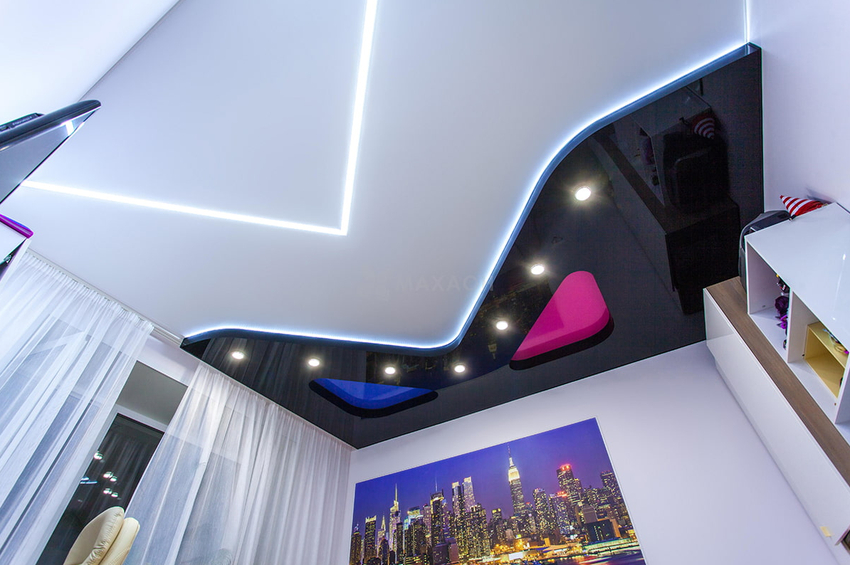
The illumination of the stretch ceiling can bend around the contour of the box, be located around the perimeter, be built-in or installed specially for display
LEDs of various shapes and powers are used as lighting elements. Such a source of artificial light is safe for the human body, since it does not emit toxic components into the atmosphere. It does not have a negative effect on the organs of vision. Stretch ceiling LED lighting requires a minimum amount of electricity.
Such lamps are ergonomic, resistant to voltage drops, and provide an even directional light. They do not heat up during operation, therefore they do not require a substrate, being located inside the structure.
LED-lamps can be presented in the form of flat panels, spotlights, spots, neon cords, fiber-optic filaments, flexible LED strips. The last two options are often mounted under a tensioning structure. In this case, a translucent or transparent film is used. Backlit stretch ceilings reproduce unique effects.
Important! The most laborious is the installation of a stretch ceiling with illumination from fiber-optic filaments, which requires the creation of holes in one of the layers for LED output.
Types of luminaires for point and tape type stretch ceilings
Spot lighting is performed in the form of special lamps, spotlights and spots. The first option is represented by built-in appliances, which differ in the type of lamps and the method of fixation. Another type of spotlights for stretch ceilings are spots, which provide directional lighting due to the fact that they are adjustable in tilt angle. Such lighting fixtures can be directed to a specific element of the interior. Different options are shown in the photo of stretch ceilings with spotlights.
As a backlight for a stretch ceiling, LED strips are most often used. Thanks to the flexibility of the products, they smoothly frame all the lines of the structure. These light sources provide uniform, controlled illumination.
For the design of the ceiling surface, neon cords are often used, which are characterized by a large number of shades. Such a light source consumes a lot of electricity and has a short operating period.
Fiber optic cable has a large number of plastic or glass conductors that conduct light. This structure prevents light from scattering outside the fibers.This lighting option is used when arranging point light sources.
Helpful advice! To create a starry sky on the ceiling, it is best to use diode mini-devices, which are shown in the photo of lamps for stretch ceilings.
Stretch ceiling lighting is presented in a wide range of shades. In addition to neutral classic solutions, you can choose color options for neon lighting. When choosing the tone of light for lighting sources for rooms, you should not use yellow and too cold blue shades, which contribute to creating a depressing atmosphere and the development of depression. Blue, purple and red colors are also contraindicated.
Features of a stretch ceiling with lighting around the perimeter
The perimeter-illuminated stretch ceiling is characterized by simplicity and functionality. When arranging it, a significant lowering of the level of the ceiling surface is not required, so that the structure can be mounted in small-format rooms.
Such a ceiling is a combination of a plasterboard frame and a stretch canvas. It can be two-level or multi-level. The upper part, on which the light falls, is the ceiling sheet, and the lower tier is a plasterboard case, where the backlight is hidden. The frame can be of various designs. The simplest configuration is considered to be a regular ramp around the perimeter of the room.
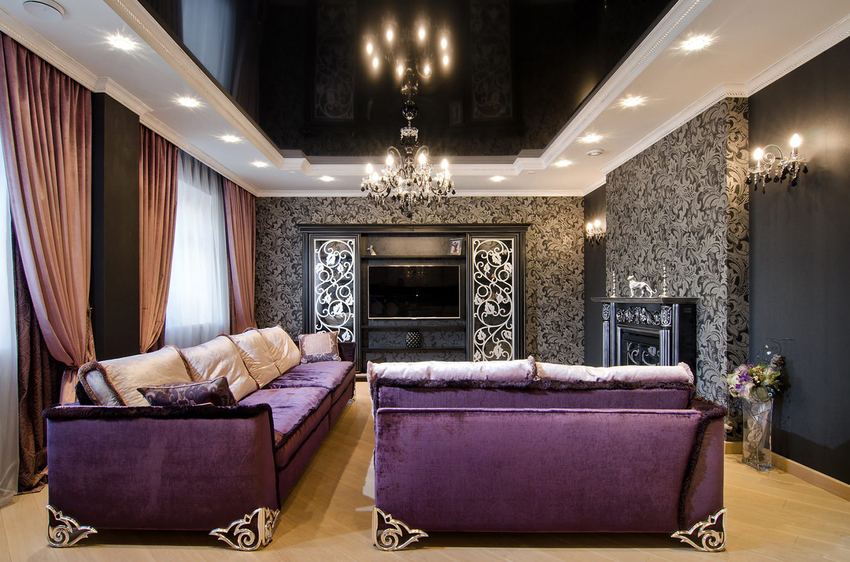
Stretch ceiling with lighting around the perimeter is a combination of canvas and plasterboard frame, in which the lighting is hidden
For such a ceiling, contour lighting can be used, which is performed along the perimeter of the surface in the form of a single luminous flux or separate points. You can also equip a floating stretch ceiling with lighting, the price of which is on average 800-1000 rubles /m²... Such a technique with a cornice fastening of light sources contributes to a visual increase in the room. This creates the effect of a ceiling floating in the air, which does not seem to touch the walls.
The most popular lighting option is the use of LED strip under a stretch ceiling along the perimeter of the structure, which is located in niches on the sides of the plasterboard contour. In this case, the effect of the emergence of light from nowhere is formed, which visually expands the space. However, this design is prone to dust accumulation on the inner surface of the plasterboard circuit.
Arrangement of stretch ceiling with LED lighting
To equip a ceiling with an LED strip, the first step is to install a plasterboard box. For this, a frame made of aluminum guides with a step of 60-70 cm is installed. The elements are attached to the ceiling and walls along the perimeter of the room with dowels. For this, holes are pre-made in the structures using a perforator.
Important! When installing a drywall frame, it is necessary to check the evenness of the fasteners of the entire structure.
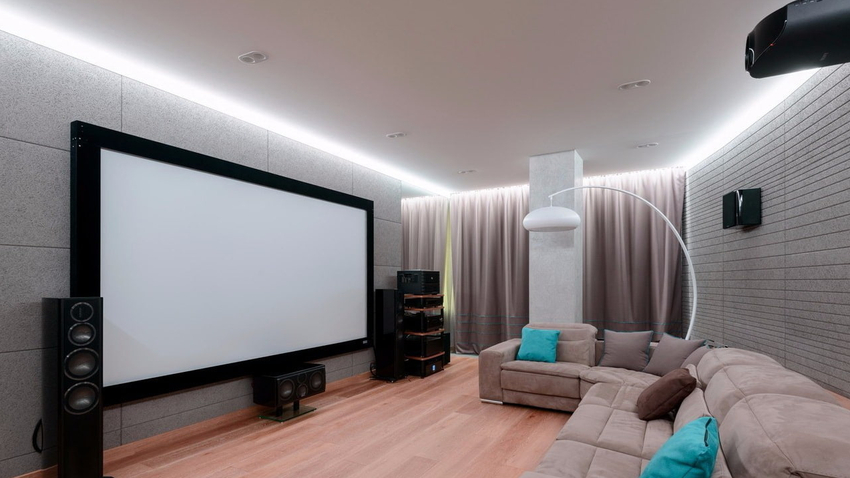
Arrangement of a stretch ceiling with LED lighting can be either with the use of a drywall box or without it
Outside, the frame is sheathed with plasterboard. The lower elements are attached first, and then the side ones. The material is fixed with self-tapping screws, which should be sunk 0.5-1 mm deep. The lower edge of the structure is made with some protrusion of 8-10 cm, from where another protrusion with a height of 5-7 cm departs. Thus, a niche is formed for illuminating the ceiling with an LED strip.
There should be a gap of about 10 cm between the surface of the ceiling and the edge of the vertical ledge, which is necessary to tighten the canvas. All butt joints of the material and the places of fastenings are closed with bandage tapes, followed by puttying.For the design of the corners, metal corners are used, which are fixed with a starting putty. A baguette is attached to the vertical part of the structure, into which a tension canvas is inserted. An LED cord is mounted in the resulting niche. The result of the work is shown in the photo of the ceiling with lighting around the perimeter.
A kind of backlit stretch ceiling: a floating ceiling
A soaring stretch ceiling with illumination around the perimeter looks like a weightless surface. This is due to the fact that the lighting is located on a special profile, which is mounted between the wall and the ceiling. A synthetic canvas is attached to its lower part. Light hitting the walls is scattered in space. Such a ceiling visually increases the height of the room and fills it with space.
To equip a floating structure, you can use a profile for a stretch ceiling with illumination of various designs, on which a special element is applied. With its help, light is scattered, while at the same time it acts as a decorative element. The single-level structure can be mounted using a profile without gaps. As a result, the diode tape is positioned over the canvas through which light flows. The flexible profile option allows you to create various shapes on the ceiling.
The universal type of material makes it possible to obtain diffused lighting, which, reflected from the wall surfaces, falls back onto the ceiling, creating the illusion of soaring. To create multidirectional illumination, a profile with holes and gaps for illumination is used.
Installation of a floating stretch ceiling with lighting inside
Installation of a floating ceiling is a simple process. It consists of installing an aluminum profile, fixing the light source and stretching the synthetic canvas. Profile docking is carried out at an angle of 45 degrees, followed by grinding of the edges. It is attached to the wall along the perimeter of the room with dowels. Next, an LED strip is inserted into a special niche. Mounted inserts for chandeliers or built-in lamps (if installed).
Important! The LED strip is not glued to the profile, but inserted into a special groove on the baguette.
The final stage is the stretching of the web, which is heated with a heat gun, which must be at a certain distance. The material is pushed into the mounting groove on the profile by means of a paddle. The installation process starts from the corners.
After fastening in the first corner, the web is tucked in from the opposite side, then in the two remaining corners. Next, the material is fixed on the sides. At the final stage, a soft tape is attached around the perimeter of the room, which will act as a diffuser. Interesting design options are shown in the photo of a floating stretch ceiling with lighting.
Organization of illumination of a stretch ceiling with LED strip
LED strip is a cord wound on a spool. The length of the tape is usually 5 m. One light source can handle up to 15 m of material. If the limit is exceeded, an additional cable must be used.
LED lighting is mounted mainly in niches between the tension surface and the ceiling plinth, which allows it to be hidden from visual viewing. By varying the distance between the light source and the ceiling surface, the lighting effect is corrected. Thus, you can create brighter accent spots or get soft diffused lighting, as shown in the photo of a stretch ceiling with an LED strip.
Important! To illuminate curved sections of the ceiling structure, remember that the bending radius of the tape should not be less than 2 cm, which could otherwise damage it.
The installation of the LED strip should be done with great care so as not to damage the integrity of the cord. Due to the formation of even minor mechanical damage, conductive elements may suffer. It is important not to reverse the polarity when connecting the tape to the power source. Additionally, a controller must be present in the circuit.
The backside of the LED strip has a self-adhesive base for fixing the element to the surface, which must be flat and free from grease. In the absence of an adhesive coating, double-sided tape is used. You can also use screws or dowels, which will remove the backlight without the risk of damaging the finish.
Important! If the LED strip is mounted on a metal base, an insulating substrate of dielectric material should be provided.
Due to its aesthetic and attractive appearance, a wide range of styles, ease of installation, backlit stretch ceiling is one of the most popular options for decorating the ceiling space, with it the modern interior will sparkle with new colors.
